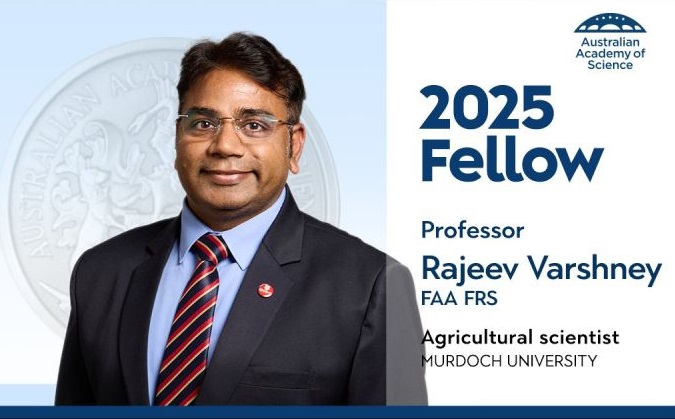Professor Varshney, the only one from Western Australia among the 26 scientists elected in 2025, joined the distinguished cohort of new Fellows during Science at the Shine Dome, the Academy’s flagship event that celebrates the global impact of Australia’s top scientists.
Now one of Australia’s leading voices in agricultural genomics, Professor Varshney’s journey began in the farmlands of India, where the vision of food security shaped his career path. Inspired by the legacy of Indian agricultural pioneers like M.S. Swaminathan—the “Father of India’s Green Revolution”—and Nobel Laureate Norman Borlaug, Varshney built a career spanning three continents, dedicated to using science to ensure farmers can feed a growing world.
At Murdoch University, he serves as Director of the Centre for Crop and Food Innovation, Director of the WA State Agricultural Biotechnology Centre, and International Chair – Agriculture and Food Security. His research achievements include decoding the genomes of more than a dozen crops, developing the Genomics-Assisted Breeding (GAB) framework, and pioneering the concept of the super-pangenome—tools that have transformed global crop improvement programs.
Professor Varshney currently leads cutting-edge projects with partners such as the Grains Research and Development Corporation (GRDC) and Hort Innovation to boost productivity in Australian cereals, legumes, and horticultural crops. His work also reaches back across India and many countries in Asia and Africa, where genomics-led breeding programs he established have helped lift millions of smallholder farmers out of poverty.
Reflecting on the honour, Professor Varshney said: “It is an honour to be recognised by my peers for my contributions to agricultural research in Australia and abroad. I have long admired Australia’s rich agricultural heritage, with pioneers such as William Farrer paving the way for our robust and internationally competitive sector.
I’ve been incredibly fortunate to meet and work with transformative scientists, such as Norman Borlaug and M.S. Swaminathan. Their inspirational efforts to usher in a more sustainable and equitable agricultural sector played a major role in my research focus, which is to deliver innovative solutions to the most pressing challenges facing global food production.
Leading two of Western Australia’s most dynamic research centres has been an immense privilege. Through the support of our investors, collaborators, my team, and the research leaders at Murdoch University, we’re making significant steps towards the development of climate-resilient, highly productive and more nutritious crops.”
At the Shine Dome, Professor Varshney presented “Decoding Crops, Delivering Impact,” where he outlined challenges facing Australian agriculture and showcased how genomics can provide solutions. Using chickpeas as an example, he described how the first Australian chickpea pangenome revealed the absence of a key QTL hotspot that enables heat and drought tolerance in Indian varieties—demonstrating how cross-continental knowledge can unlock new potential for Australian crops.
Murdoch University’s Vice Chancellor, Professor Andrew Deeks, praised the election as recognition of Varshney’s outstanding global impact: “Professor Varshney represents Murdoch University’s ethos of delivering translational research, and his contributions to the field over his relatively short career have been tremendous. As Murdoch University’s only Fellow of the Royal Society and our second elected Fellow of the Australian Academy of Science, he has been an outstanding ambassador of research excellence for the University and for Western Australia.”
In his presidential address, Professor Chennupati Jagadish AC, another Indian-origin scientist and President of the Academy, reminded the audience: “We are lucky that so many Fellows, around half of whom were born overseas, call Australia home. Lucky that our research is of the highest quality. So good that it is developed into technologies, too often by other countries. Lucky that our researchers are such prolific international collaborators, enabling Australia to access 97% of the knowledge generated elsewhere, and adapted to the needs of our people. Our research capability is something we should never take for granted.”
Professor Varshney had an opportunity to meet and interact with many research leaders during the celebration of Fellowship in Canberra. The list includes Senator the Hon. Tim Ayres, Minister for Industry and Innovation and Minister for Science, and Prof. Tony Haymet FTSE, Chief Scientist of Australia, Prof. Stephen Powles FAA, Prof. Peter Langridge FAA, Prof. Barry Pogson FAA, Prof. John Kirkegaard FAA, Prof. TJ Higgins AO, Prof. James Arvanitakis (Director, Forrest Research Foundation), and many more.
Professor Varshney’s Fellowship symbolises this global spirit—carrying the inspiration of India’s Green Revolution into the heart of Australian science, and uniting two agricultural powerhouses in the shared mission of feeding the world.
